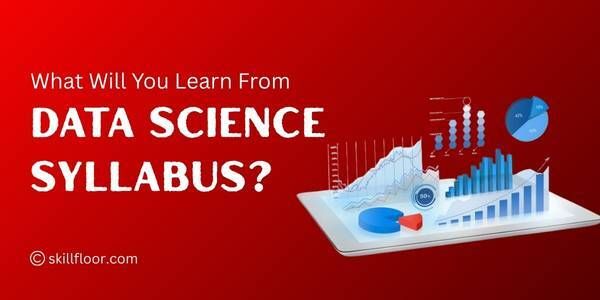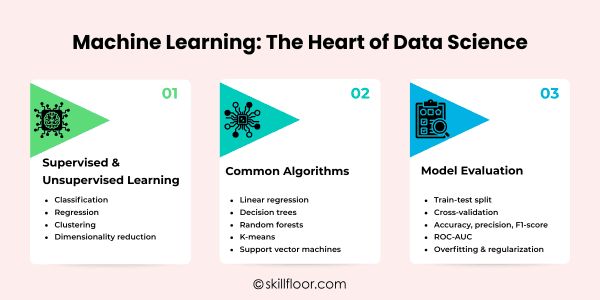Exploring the Data Science Syllabus: An Exciting Journey
Discover the complete data science syllabus through a storytelling lens. Explore key topics, insights, and the exciting journey behind mastering data science.

If you're reading this, you've probably been struck by data science, a field that seems to be everywhere and influencing everything. Data science works in the background to make smarter, quicker, and better decisions about everything from the things you purchase to the movies you watch.
And maybe you've wondered:
“What does it actually take to learn this stuff?”
“What’s really inside a data science syllabus?”
“Is it something I could handle… or is it reserved for math geniuses and code wizards?”
Let's be clear: you are more than capable of managing this journey. It's more than simply a list of subjects; it's a transformation that changes one's perspective, self-assurance, and method of problem-solving.
Today, we're not only studying the data science syllabus; we're starting on an effective journey that thousands of others take to secure their professional futures. Trust yourself if you've ever thought you might miss out.
Why the Data Science Syllabus Matters More Than Ever
Look around. The world is speaking data.
-
91% of businesses are increasing investments in data analytics.
-
Data scientist roles have grown 650% since 2012 and continue to stay in the top tier of global job rankings.
-
Nearly 80% of organizations say they struggle to analyze data fast enough, creating massive demand for skilled data professionals.
-
Over 97% of businesses have invested in big data initiatives to stay competitive in a data-driven economy.
People who are adept at analyzing, shaping, and modeling data are not just staying up to date, but also taking the lead. A good data science course becomes the road map that enables you to join them with genuine assurance.
The syllabus might be difficult when you first look at it. Programming, statistics, machine learning, big data, and visualization all seem complex until a structured data science course breaks them down into their parts.
A Comprehensive Walkthrough of the Data Science Syllabus
1. Foundations: The Building Blocks
Learning Python or R for data manipulation, comprehending fundamental statistics, and developing mathematical intuition that facilitates further in-depth analysis and upcoming machine learning principles are the foundational skills of data science.
Programming Basics
The majority of programs begin with Python or R due to their industry-wide usage, ease of use, and strength. You'll find out:
-
Writing simple scripts
-
Manipulating data
-
Using essential libraries like NumPy and Pandas
Mathematics and Statistics
You don't have to be a mathematician, so don't worry. You'll discover the important math:
-
Probability
-
Linear algebra
-
Statistical tests
-
Data distributions
You may understand model behavior and make precise analytical conclusions by using mathematics and statistics to uncover underlying patterns and principles.
Databases & Data Management
Information is arranged, stored, and structured by databases and data management, guaranteeing that each dataset has a trustworthy source.
Learnings include:
-
SQL fundamentals (SELECT, JOIN, GROUP BY)
-
Working with relational databases
-
Introduction to NoSQL databases
-
Basics of data warehouses and data pipelines
This module teaches learners where data comes from and how to access it efficiently.
2. Core Data Science Skills
Fundamental information is transformed into practical abilities through core data science skills, which enable you to efficiently manage data, uncover insights, and resolve real-world problems.
Data Wrangling & Cleaning
Raw data is untidy. To prepare datasets for analysis, you will learn how to clean, transform, and arrange them.
By eliminating mistakes, standardizing formats, and enhancing datasets, data wrangling guarantees high-quality inputs for your models. Gaining proficiency in these methods provides a solid basis for precise, trustworthy, and significant analysis.
Exploratory Data Analysis (EDA)
Using summaries and visualizations, exploratory data analysis helps identify patterns, trends, and anomalies so you can comprehend data before creating predictive models.
This module includes:
-
Handling missing values
-
Removing outliers
-
Dealing with inconsistent formats
-
Feature engineering
-
Visualizing trends and patterns
As students examine patterns, disclose insights, and find significant narratives concealed inside unprocessed, intricate statistics and data, EDA piques their interest.
Data Visualization
Visuals are easier for humans to understand than numbers. For this reason, one of the syllabus's most inventive components is data visualization.
Students learn tools like:
-
Matplotlib
-
Seaborn
-
Plotly
-
Tableau
-
Power BI
The objective is to turn insights into dashboards, infographics, and narratives that decision-makers can quickly comprehend.
3. Machine Learning: The Heart of Data Science
By enabling computers to recognize patterns, predict outcomes, and resolve challenging issues, machine learning makes data come to life.
Supervised & Unsupervised Learning
-
Classification
-
Regression
-
Clustering
-
Dimensionality reduction
Common Algorithms
-
Decision trees
-
Random forests
-
K-means
-
Support vector machines

Model Evaluation
You'll discover how to steer clear of traps like overfitting and assess model performance using techniques like:
-
Train-test split
-
Cross-validation
-
Accuracy, recall, precision, F1-score
-
ROC-AUC
-
Overfitting & regularization
4. Advanced Topics: Diving Deeper
The field of data science grows into more advanced, cutting-edge domains as you advance.
Deep Learning
Deep learning mirrors the human brain, which advances machine learning.
Learners explore:
-
Neural network architecture
-
Activation functions
-
Backpropagation
-
CNNs for image processing
-
RNNs for text and sequence data
-
Basics of Transformers
Big Data Technologies
In real-world settings, managing large datasets is essential, requiring distributed computing systems and scalable solutions like:
-
Hadoop
-
Spark
-
Distributed computing principles
Natural Language Processing (NLP)
Natural language processing enables advanced applications across communication-focused data tasks by teaching computers how to evaluate text, extract meaning, comprehend sentiment, and produce language.
Model Deployment & MLOps
Developing a model is only half the work; the true impact occurs during deployment.
Learners study:
-
Model deployment using Flask / FastAPI
-
Docker and containerization
-
Cloud platforms like AWS, Azure, GCP
-
Monitoring and retraining models
This provides students with a comprehensive understanding of the Data Science workflow from beginning to end.
Domain Knowledge & Real-World Applications
Domain knowledge enables data scientists to customize solutions for particular sectors, using the appropriate methods and perspectives to successfully address practical, industry-specific problems.
1. Healthcare: Diagnosing Diseases
Data science is used in the healthcare industry to evaluate medical records, forecast illness risks, enhance diagnostics, and assist physicians in making quicker, more precise decisions about patient treatment.
2. Finance: Fraud Detection
Machine learning models are used in finance to evaluate credit risks, identify fraudulent transactions, examine consumer behavior, and bolster financial security using real-time information.
3. Retail: Inventory Forecasting
Data science is used by retailers to predict demand for inventory, optimize stock levels, cut waste, and guarantee that goods are available when customers need them most.
4. Marketing: Customer Segmentation
By analyzing audience activity across several platforms, marketing teams may use analytics to segment customers, customize campaigns, forecast preferences, and boost engagement.
5. Sports: Performance Analytics
Data science is used by sports organizations to assess player performance, avoid injuries, improve training plans, and make data-driven decisions that provide them a competitive edge.
6. Education: Personalized Learning
Education systems use data to monitor student progress, customize learning routes, spot problems early, and improve teaching efficacy using practical insights.
Comprehending the field enables data scientists to develop precise and pertinent answers, transforming unprocessed findings into significant actions that generate practical benefits and influence.
Ethics, Privacy & Responsible AI
In order to direct responsible AI, a responsible syllabus emphasizes accountability, justice, transparency, privacy, and moral decision-making:
1. Bias in Datasets
Unfair results are caused by bias in datasets, necessitating careful detection, mitigation, and balanced data collection methods.
2. Fairness in Model Predictions
Promoting equitable decision-making across various user groups and preventing prejudice are two benefits of ensuring model predictions are fair.
3. Data Privacy Regulations
Through safe management, anonymization, compliance, and ethical business practices, data privacy laws safeguard people's personal information.
4. Ethical Use of AI
AI used ethically guarantees open, responsible, and socially conscious systems that prevent negative outcomes.
5. Transparency in AI Systems
By providing clear explanations of choices, constraints, data utilization, and behavior, transparency in AI models increases confidence.
6. Accountability in AI Development
Developers and organizations must assume accountability for the results, mistakes, dangers, and effects of AI.
This guarantees that students comprehend not only how to construct models but also how to do it properly.
Capstone Projects & Portfolio Building
Projects are necessary for the student to become a professional. They show off your skills, highlight practical problem-solving techniques, and assist you in developing a solid, reliable portfolio.
A good syllabus includes:
-
End-to-end real-world projects
-
Guidance on dataset selection
-
Portfolio presentation tips
-
GitHub best practices
Completing capstone projects and developing a polished portfolio helps students succeed in competitive job interviews by showcasing their professionalism, problem-solving abilities, and practical skills.
Tools & Ecosystem
To effectively manage projects and workflows, contemporary data scientists rely on flexible technologies for coding, visualization, collaboration, version control, and cloud computing:
-
Jupyter Notebook
-
Git & GitHub
-
SQL
-
Cloud platforms (AWS, Google Cloud, Azure)
Data scientists may effectively analyze data, manage projects, work with teams, and provide significant, high-caliber solutions by becoming proficient with these tools.
The Future of Data Science
Data science is still developing quickly due to advancements in automation, artificial intelligence, and computing technology. As the environment becomes more complicated, professionals in this industry will need to adjust to new technologies, approaches, and ethical issues. AI's incorporation into business, healthcare, finance, and other sectors will open up previously unheard-of possibilities for creativity and decision-making.
Key Trends and Focus Areas:
-
Artificial Intelligence & Machine Learning: Smarter, automated models with predictive and prescriptive capabilities.
-
Ethical and Responsible AI: Ensuring fairness, transparency, and accountability in AI systems.
-
Augmented Analytics: Combining human expertise with AI-powered data insights.
-
Quantum Computing: Accelerating complex computations and big data processing.
-
Cloud & Edge Computing: Distributed data storage and real-time analytics.
-
Cross-disciplinary Skills: Combining domain expertise with data science, communication, and problem-solving abilities.
Examining the data science curriculum is like opening a door to a universe of possibilities. Every subject, from statistics and coding to machine learning and practical projects, develops abilities that are not only practical but also thrilling to employ. Although it may seem like a long road at first, each step increases your understanding and self-assurance. Along the way, you'll learn how data can solve issues, tell stories, and truly impact a variety of industries, including retail, sports, healthcare, and finance. Anyone may become a competent data scientist prepared to take on problems and produce solutions that genuinely matter by practicing with projects, learning the appropriate tools, and keeping ethics in mind.






























































